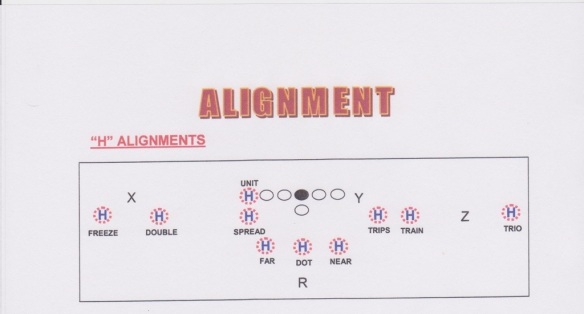Thank you to Bill Mountjoy for sharing this information. Finding ways to eliminate rote memorization of formations allows your players to align in many more formations easily and thus makes your offense very multiple. There are several methods of naming formations to accomplish this and Coach amount joy shares his here:
How we use MANY formations by moving only ONE MAN (*”H”).
Below is the THEORY behind our Offense. NOTE: QB may be UNDER, or in “Pistol”:
OFFENSIVE THEORY
The easiest approach – and the logical one – is to think of the set-up as you would the “I”. But, now you have the “I” fullback up near the L.O.S. on either side, and he is called the “H” back.
I. DOUBLE
X—————O-O-C-O-O-Y
————-H——–Q————————Z
———————–R
II. TRIPS
X—————O-O-C-O-O-Y
———————–Q————H————Z
———————–R
Much of your motion comes from moving your “H” from one side to the other. The movement creates problems for the defense in that they must determine how to support the corner of the defense and at the same time account for coverage on each receiver.
By being close to the L.O.S., the “H” back has a higher percentage block than your ordinary “I” fullback would have. At the same time, the “H” position allows a quicker release if he is to be a receiver. Of course, he is not the running threat that your “I” fullback would present, but most “I” teams do not run the fullback as a feature anyway. In addition, you do not have the versatility (of having strength to either side on the snap) that you have in the “I”. However, the position close to the L.O.S. does compensate for all of this by being a more effective blocker and receiver as a “H” back (and forces the defense to protect an extra gap). And with the created defensive problems (with movement) as an “H”, it more than compensates for the reduced element of surprise. We use our “Counter-Gap” play to keep the defense honest and not over-compensate for the position of the “H” back. A very effective play.

101+ Pro Style Pistol Offense Plays illustrates a similar simple offensive formation system that allows you to move the H-Back or Slot Receiver with a number system. The number system extends into the motions and very little terminology is necessary which means it’s easy for the players to learn. Get it from the iBookstore for you iPad here: https://itunes.apple.com/us/book/101+-pro-style-pistol-offense/id611588645?mt=11

